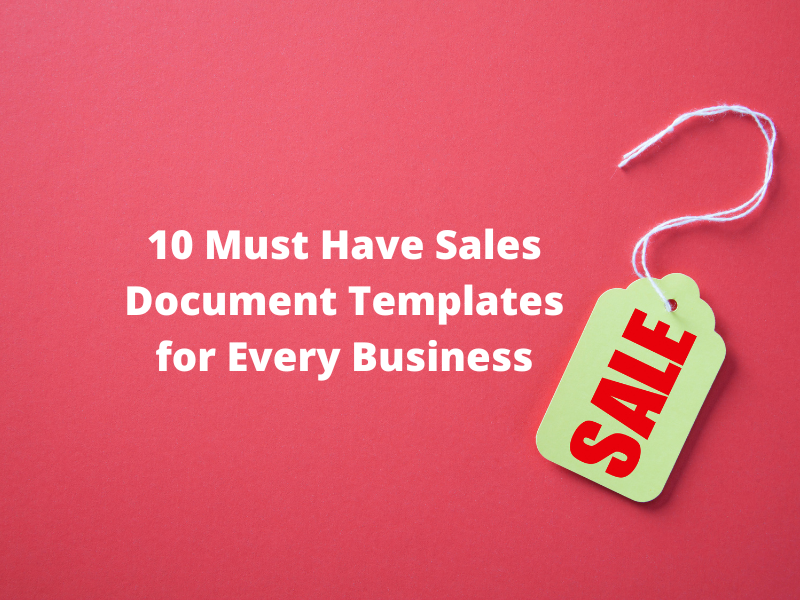10 Must Have Sales Document Templates for Every Business
10 Nov 2023
27 Jan 2023
min read

Sales documents are essential to ensuring that your business runs smoothly. Having ready-made templates for these documents can help effectively cut down the amount of time spent on repetitive writing.
In this blog post, we will take you through the basics of conducting a sale, as well as ten sales document templates you must have ready by your side as a business.
The Life Cycle of a Sale
Most established businesses will usually follow a structured sales cycle in order to optimise their sales and to maximise profit. While sales cycles can vary from business to business to suit their individual needs, there are often three key stages: (A) negotiating the sale, (B) Closing the sale, and (C) Analysing prospective needs for the future. This blog will now walk you through each part of the process, as well as explain the key document templates you need along the way.
(A) Negotiating the sale
1. Sales Communication Letter Templates
Every sale starts with promoting your product to the client. A common form of sales communication used nowadays is via online newsletters or social platforms like email. Your sales communication letter should carry a punch and attract the attention of your audience.
A possible way to do this would be to offer a guaranteed timeframe of delivery, or a competitive price. Similarly, signing off on your personal behalf would help your business convey a sense of sincerity and professionalism.
DocPro offers many sales communication letter templates, which you can check out at: https://docpro.com/doc928/sales-marketing-communication-sale-of-staples-commodities
While a sales communication letter can be used for the sale of individual products, you should also have a document prepared for selling your entire franchise in the case that you want to grow or expand your business.
Prices for goods such as staplers, plates and many other objects are usually sold at a fixed price, and in such cases you will not need to issue quotes for these products on an individual basis. Instead, it is much easier to send the customer an invoice to confirm the sale.
However, when prices for goods vary or depend on certain conditions (for example, where the overall cost per item might be cheaper as the customer buys more items)-- this is where quotations come in. Similar to invoices, they are also generated before the order is confirmed and should contain a deadline for the customer’s payment.
When issuing simple documents like quotations, a swift response will especially give the customer the impression that your business is well organised and efficient and thus lead to higher conversion potential- this is where having a ready-made template can be particularly helpful.
-2.jpg)
-1.jpg)
4. Sale Agreement: Sale of Customised Product Agreement and Sale of Regular Product Agreement (Sales Contract)
Sales agreements allow the buyer and the seller to agree to develop and supply a product to meet the Buyer’s requirements. This is crucial for every sale, since it lets both parties outline their rights and obligations in the case of any future dispute.
As required by most common law jurisdictions, the agreement should ensure that the Product is reasonably fit for its purpose and is executed in accordance with an industry standard of skill, care and diligence. Therefore, agreements like this might include clauses where the development of the Product is guaranteed to go through adequate product testing, or where the seller promises to deliver a certificate of transfer to the buyer along with the product.
A Sale of Customised Products Agreement provides that the Buyer and Seller agree to develop and supply a Product to meet the Buyer's specific requirements. The Seller shall on the terms and conditions of the Agreement: (a) provide, deliver the Product in accordance with the Delivery Programme; (b) ensure that the Product is reasonably fit for its purpose and is manufactured and executed in conformity with the Specification; (c) use good quality materials, workmanship and standards and execute the Agreement with the care, skill and diligence required in accordance with best industry practice.
A Sale of Regular Product Agreement provides for a one-off purchase of goods/products. The Buyer will use the goods for its own use or resell them under its own brand. the Seller shall sell and the Buyer shall purchase the agreed quantities of the Products subject to the terms and conditions of this Agreement,
5. Terms and Conditions for Sale of Goods
A terms and conditions for sale of goods is similar to a sale agreement, but is more often employed when the sale of the goods is standard across all consumers. This document should set out both the buyer and the seller’s rights and liabilities.
Typically, the terms and conditions should include the basis of purchase, specification price, payment, delivery, quality risk and property. Once again, you should also make sure that your terms and conditions are in accordance with the law. For example, the UK has the Consumer Rights Act 2015 and the Unfair Contract Terms Act 1978, which prevent sale agreements to be unfairly imbalanced towards a single party. A suitable template can be found at DocPro: https://docpro.com/doc71/terms-and-conditions-for-purchase-of-goods-buyer-long
6. Sales Representative Commission Agreement
As a small business, it is likely that you will hire an independent sales representative to carry out sales more effectively and efficiently. However, hiring an independent contractor is different from hiring an employee– an independent contractor should still be allowed to act on behalf of other companies while an employee is exclusive to your company.
Thus, a separate sales representative is crucial to set up and should outline the details of the commission paid to your sales representative. With this document, your business can be protected from liability, in the situation where the sales representative is in dispute with you over the specifics of the commission agreement.
A typical agreement of this type will stipulate that the supplying company agrees to pay the salesperson as compensation for their services in respect of each successful sale made, a commission of XX% of the Contract Price of each sale agreement.

(B) Closing the sale
7. Sale Order
Sales Order vs. Invoice
The main difference between a sales order and invoice is that a sales order is created by a vendor to confirm they can provide the goods or services requested. On the other hand, an invoice is normally created to request payment for goods or services that have already been provided to the buyer.
These sales orders are typically provided by the seller. As the transaction is likely to be online and thus done through mail, fax, e-mail or other instantaneous communication methods, you should ensure that all the required information is provided to the customer, including;
- name of product/service,
- product/service code or number,
- unit price, sales tax and discount/ payment terms (if any)
- quantity ordered,
- pick up or delivery address,
- required date of delivery/service, and
- payment method (enclosing cheque, transfer or by instalment).
Proforma invoices are commonly a key part of international transactions.
What is the difference between a receipt and an invoice?
It is important to note that receipts are not the same thing as invoices, although they may seem similar. While receipts are given to the customer after a sale, invoices are provided before any money is sent by the customer.
Therefore, you should ensure that your invoice contains a due date for the payment, as well as the date that the invoice was sent to the customer. This ensures that any late payments from the customer can be followed up efficiently and in a transparent manner.
For proforma invoices in particular, note that the price stated is merely an estimate given in good faith. The buyer should only be notified of a conclusive price when they are issued with a commercial invoice from the seller. The proforma invoice will also often include estimates of any fees or commissions– like shipping fees or taxes– which are payable pursuant to the transaction.
A sales receipt typically immediately follows the sale of a good and is provided by the seller. After the customer successfully purchased one or more items from a shop or a company, a receipt should be issued to them to prove that the sale has been received and the purchasing procedure has been completed. The receipt also acts as a reference for the customer to realise the details such as the price, and quantity, of his/ her purchase.
As a business, having receipts are crucial because it provides the customer with a confirmation that that business is reliable and that the goods purchased are on route. This can also ensure transparency when a customer sends in a complaint that their goods have not arrived or their transaction has not been processed.
-1.jpg) (C) Analyse prospective needs for the future
(C) Analyse prospective needs for the future
10. Sales Report
A sales report should summarise a business’s sales activities, and provides fruitful insight into how your company could further improve and expand in the future. A sales report should typically contain key sales information such as sales volume, leads, new accounts, revenue and costs for a given period of time.
By analysing this raw data, these reports would help your business identify gaps within its current sales approach and show opportunities for further growth. In particular, it can provide insight into predictions of future sales data, evaluation of current performance as opposed to previous terms, and a more thorough understanding of customer motivations behind each sale. The analysis of your data might even be assisted with the growth of artificial intelligence:

Conclusion
In conclusion, these documents form the foundation of every successful business and are sure to help you increase efficiency and profitability.
Lost over where to start? Don’t worry, as DocPro has over thousands of templates readily available by your side, and is guaranteed to streamline your processes and make business as easy as one two three!
Disclaimer: Please note that this is a general summary of the position under common law and does not constitute legal advice. As the laws of each jurisdiction may be different, you may wish to consult your lawyer.
Keywords:

